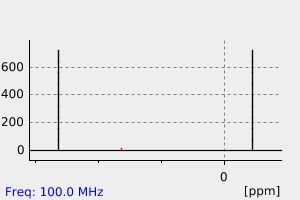叔丁基(三甲基)硅烷 | 5037-65-0
中文名称
叔丁基(三甲基)硅烷
中文别名
——
英文名称
tert-butyltrimethylsilane
英文别名
Trimethyl-tert-butyl-silan;t-butyltrimethylsilane;Silane, trimethyl-tert-butyl-;tert-butyl(trimethyl)silane
CAS
5037-65-0
化学式
C7H18Si
mdl
——
分子量
130.305
InChiKey
FFXWYTYNILTGIL-UHFFFAOYSA-N
BEILSTEIN
——
EINECS
——
-
物化性质
-
计算性质
-
ADMET
-
安全信息
-
SDS
-
制备方法与用途
-
上下游信息
-
文献信息
-
表征谱图
-
同类化合物
-
相关功能分类
-
相关结构分类
计算性质
-
辛醇/水分配系数(LogP):3.12
-
重原子数:8
-
可旋转键数:1
-
环数:0.0
-
sp3杂化的碳原子比例:1.0
-
拓扑面积:0
-
氢给体数:0
-
氢受体数:0
安全信息
-
海关编码:2931900090
SDS
反应信息
-
作为反应物:描述:参考文献:名称:芳烃离子催化全烷基化硅烷的卤代脱烷基化摘要:“有机硅”在自然界中并不存在,但现代化学很难想象没有硅与碳结合的情况。虽然含硅商品化学品(例如通过“直接工艺” 1,2,3,4产生的那些)看起来很简单,但选择性制备芳基取代和烷基取代(官能化)硅化合物(称为硅烷)并非易事。氯硅烷如 Me 4− n SiCl n ( n = 1–3) 以及 SiCl 4 ( n = 4) 是合成含硅分子的常见起点。然而这些方法常常遇到具有挑战性的分离问题5 。相反,具有四个烷基的硅烷被认为是合成的死角。在这里,我们介绍了芳烃离子催化的卤代脱烷基化反应,可有效地将 Me 4 Si 和相关的季硅烷转化为各种官能化衍生物。该反应使用烷基卤和芳烃(共)溶剂:烷基卤是卤化物源,最终与芳烃进行弗里德尔-克来福特烷基化以再生催化剂6 ,而芳烃离子则充当强布朗斯台德酸原脱烷基化步骤7 。例如,在硅药物前体的合成中,证明了自上而下的卤代烷基化方法相对于报道的自下而上程序的优势。此外,连接到烷基链上的相当惰性的MeDOI:10.1038/s41586-023-06646-9
-
作为产物:描述:叔丁基三氯硅烷 在 CH3MgBr 作用下, 以 not given 为溶剂, 以61%的产率得到叔丁基(三甲基)硅烷参考文献:名称:Gmelin Handbuch der Anorganischen Chemie, Gmelin Handbook: Si: MVol.C, 12, page 37 - 39摘要:DOI:
文献信息
-
치환된 벤족사졸申请人:BAYER PHARMA AKTIENGESELLSCHAFT 바이엘 파마 악티엔게젤샤프트(519980697332)公开号:KR20160016815A公开(公告)日:2016-02-15본 발명은 하기 화학식 I의 치환된 벤족사졸 (여기서 R은 하기 화학식 II, III, IV, V의 기를 나타냄), 및 그의 제조 방법, 및 질환, 특히 심혈관 질환, 바람직하게는 혈전성 또는 혈전색전성 질환의 치료 및/또는 예방을 위한 의약의 제조를 위한 그의 용도에 관한 것이다.
-
Three-Pronged Probes: High-Affinity DNA Binding with Cap, β-Alanines and Oligopyrrolamides作者:Rüdiger Haug、Markus Kramer、Clemens RichertDOI:10.1002/chem.201302972日期:2013.11.18TPP oligonucleotides: Hybridization probes that interrogate target sequences through base pairing, stacking on the terminus, and binding in the minor groove are presented (see figure). All subunits of the probes contribute to the target affinity, leading to melting point increases of up to 45 °C. (TPP=three‐pronged probe)
-
A method to derivatize surface silanol groups to Si-alkyl groups in carbon-doped silicon oxides作者:Srikar Rao Darmakkolla、Hoang Tran、Atul Gupta、Shankar B. RananavareDOI:10.1039/c6ra20355h日期:——
A carbon-doped silicon oxide (CDO) finds use as a material with a low dielectric constant (
k ) for copper interconnects in multilayered integrated circuits (ICs). -
The gas-phase acidities of the alkanes作者:Charles H. DePuy、Scott Gronert、Stephan E. Barlow、Veronica M. Bierbaum、Robert DamrauerDOI:10.1021/ja00188a003日期:1989.3acidities of 15 simple alkanes have been determined in a flowing afterglow-selected ion flow tube (FA-SIFT) by a kinetic method in which alkyltrimethylsilanes were allowed to react with hydroxide ions to produce a mixture of trimethylsiloxide ions by loss of alkane and alkyldimethylsiloxide ions by loss of methane. The reaction is proposed to proceed by addition of hydroxide ion to the silane to form在流动余辉选择离子流管 (FA-SIFT) 中,通过动力学方法测定了 15 种简单烷烃的气相酸度,其中烷基三甲基硅烷与氢氧根离子反应生成三甲基硅氧离子混合物。烷烃和烷基二甲基硅氧烷离子通过失去甲烷。该反应建议通过向硅烷中加入氢氧根离子以形成五配位硅酸根离子中间体,该中间体通过两种过渡态分解,一种是在甲基上带负电荷,另一种是在甲基上带负电荷。烷基。产生的硅氧根离子的比例被认为与甲基和烷基阴离子的相对碱度相关。该方法使用已知的甲烷酸度 (/Delta/H/亚酸/) = 416 进行校准。6 kcal/mol 和苯(/Delta/H/度//亚酸/ = 400.7 kcal/mol)。一般而言,发现甲基取代可稳定气相中的烷基阴离子,但发现乙基阴离子比甲基阴离子碱性更强。通过将气相酸度与键解离能结合起来,可以计算出相应烷基的电子亲和力 (EA)。发现许多更简单的烷基自由基具有负的 EA。给出了所研究烷基的结果。«
-
Cleavage of Unactivated Si−C(sp<sup>3</sup>) Bonds with Reed's Carborane Acids: Formation of Known and Unknown Silylium Ions作者:Qian Wu、Zheng-Wang Qu、Lukas Omann、Elisabeth Irran、Hendrik F. T. Klare、Martin OestreichDOI:10.1002/anie.201805637日期:2018.7.16An efficient method for the benzenium‐ion‐mediated cleavage of inert Si−C(sp3) bonds is reported. Various tetraalkylsilanes can thus be converted into the corresponding counteranion‐stabilized silylium ions. The reaction is chemoselective in the case of hexamethyldisilane. Computations reveal a mechanism with backside attack of the proton at one of the alkyl groups. Several activated Si−C(spn) bonds
表征谱图
-
氢谱1HNMR
-
质谱MS
-
碳谱13CNMR
-
红外IR
-
拉曼Raman
-
峰位数据
-
峰位匹配
-
表征信息
同类化合物
镁己烷
锌,二环己基-
锂,3-辛炔基-
锂,(1-苯基乙基)-
铜(I)己基乙炔化物
铜(1+),2-甲基丙烷
铅杂鎓,二乙基甲基-
钠,(1,2,3,4-四甲基-2,4-环戊二烯-1-基)-
钛(4+)四(2,2-二甲基丙烷-1-I去)
邻苯二甲酰基
邻甲基二苯甲酮自由基阳离子
辛烷钠
苄基铜
苄基钠
脱羰秋水仙碱
胂,二(2,2-二甲基丙基)-
纳米碳化钛
红陪酚四甲基醚
红倍酚
秋水仙碱甲硫代磺酸盐
秋水仙碱
碳化锆
碳化铪
碳化铌
碳化铀
碳化钽
碳化钒
碘二氟甲基(1+)
硼化二铬
硫代秋水仙碱
硅烷,二甲基丙基-
硅烷,乙基二甲基-2-丙烯基-
硅烷,乙基二(3-甲基丁基)-
石墨溴化物
甲烷,钼
甲基锡烷
甲基铍氢化物
甲基辛基硅烷
甲基硅烷基阳离子
甲基硅烷
甲基二乙烯基硅烷
甲基丙烯酸7-氧代-4-(苯基偶氮)-1,3,5-环庚三烯-1-基酯
甲基三烯丙基硅烷
甲基三正辛基硅烷
甲基三正己基硅烷
甲基三乙基硅烷
甲基三-N-癸基硅烷
甲基6-肼基-7-氧代-1,3,5-环庚三烯-1-羧酸酯
甲基-三-n-丁基硅烷
甲基(三丙基)硅烷







